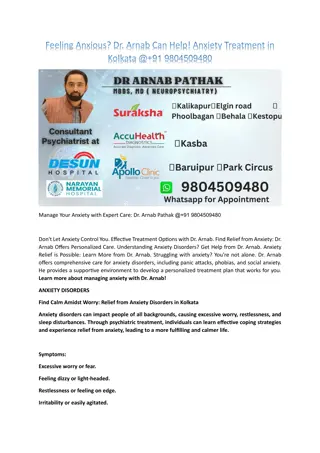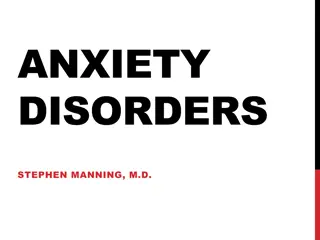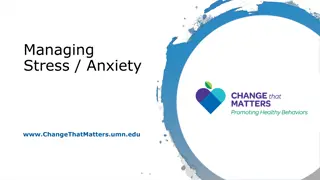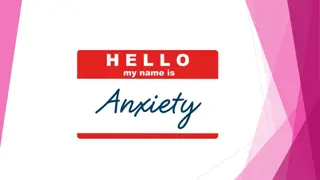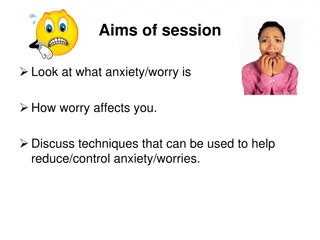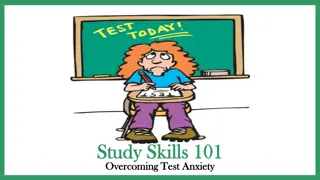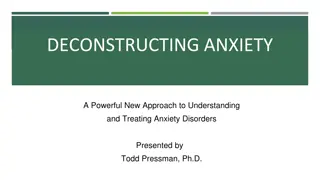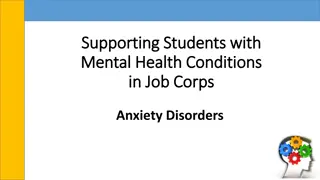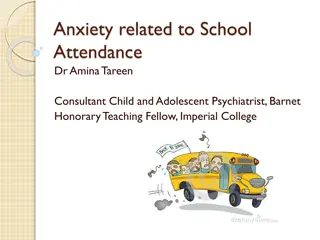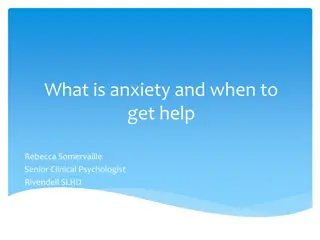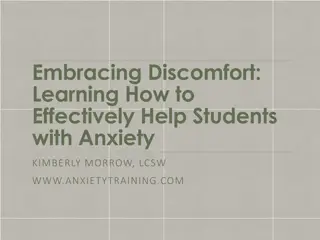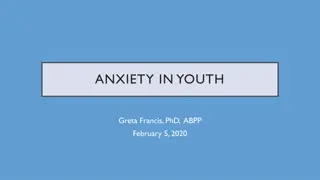Understanding Anxiety in Students: Impacts and Disorders
Anxiety in students can manifest as excessive worry, stress, and physical symptoms that interfere with daily life. Generalized anxiety, social anxiety, panic disorders, and PTSD are among the various forms of anxiety disorders that may affect students in the classroom. Recognizing and addressing these issues is crucial for supporting students' mental well-being and academic success.
Download Presentation

Please find below an Image/Link to download the presentation.
The content on the website is provided AS IS for your information and personal use only. It may not be sold, licensed, or shared on other websites without obtaining consent from the author. Download presentation by click this link. If you encounter any issues during the download, it is possible that the publisher has removed the file from their server.
E N D
Presentation Transcript
Anxiety Working with students in the classroom
What is Anxiety? An emotion characterized by feelings of tension, worried thoughts and physical changes like increased blood pressure. (APA--American Psychological Association) People with anxiety disorders usually have recurring intrusive thoughts or concerns. They may avoid certain situations out of worry. They may also have physical symptoms such as sweating, trembling, dizziness or a rapid heartbeat. (APA) Childhood anxiety disorders occur when feelings of stress or fear persist and are intense enough to interfere with everyday life. Childhood anxiety disorders can take many forms, but all involve excessive worry and stress. (UCLA CARES--Child Anxiety Resilience Education and Support)
Anxiety: Psychological and Physical Anxiety is a reaction to stress In short term, anxiety prepares us to confront a crisis by putting body on alert (Fight or Flight!) Heart and breathing rates increase Muscles tense Blood flow diverted from abdominal organs to the brain Counterproductive physical effects Short-term: light-headedness, nausea, etc.
Prevalence 25% of 13 to 18 year olds experience anxiety. (National Institute of Mental Health)
Anxiety Disorders Generalized anxiety: Worry about a wide variety of everyday things Often worry about school performance and can struggle with perfectionism. Social anxiety: Excessively self-conscious, making it difficult to participate in class and socialize with peers. Selective mutism: Difficult time speaking in some settings Obsessive-compulsive disorder (OCD): Unwanted and stressful thoughts Attempt to alleviate anxiety by performing compulsive rituals like counting or washing hands. Specific phobias: An excessive and irrational fear of particular things, such as animals or storms. (Childmind.org)
Anxiety Disorders, continued Panic disorder: Recurrent panic attacks that include symptoms such as sweating, trembling, shortness of breath or a feeling of choking, a pounding heart or rapid heart rate, and feelings of dread Attacks often happen suddenly, without warning. People who experience panic attacks often become fearful about when the next episode will occur, which can cause them to change or restrict their normal activities. Post-traumatic stress disorder (PTSD): Can develop after a severe physical or emotional trauma Symptoms include flashbacks of the trauma, nightmares and frightening thoughts that interfere with a person's everyday routine for months or years after the traumatic experience. (APA)
Sources of Anxiety (Counselor Observations) Family Fighting Instability (multiple homes, frequent moves, inconsistency) Financial struggles Drug/alcohol abuse Peer conflicts and relationship issues Pressure to excel (grades, extra-curricular activities)
Observable Symptoms Restlessness Repetitive questioning Inattention Problems in specific subjects Attendance problems Worry excessively about failing an exam, leading to failed performance ( shutting down ) Frequent visits to the nurse Aggressive behaviors Feel extremely fearful of a disaster or other events out of their control Disruptive and repetitive behavior Refuse to eat or use restrooms at school Avoidance of social situations with peers (GSCA Journal, Childmind.org, and UCLA CARES)
What To Be Aware Of Anxiety in children is often more noticeable during periods of transition and during unstructured time (UCLA CARES) You may never know someone in your class is dealing with anxiety. You are not expected to talk students through their anxiety or fill the role of the counselor.
What NOT To Do Don t remove stressors Don t minimize their fears and anxieties Don t ask leading questions Don t bring others attention to them (GSCA Journal and Childmind.org)
What To Do Talk to them one-on-one (in hallway, Counseling Office, etc.) Express your expectations clearly (be specific) Talk through the schedule, especially when there are changes, so students feel prepared for what is coming next Develop routines Emphasize cooperation and minimize competition Encourage your students and their progress Talk through worst case scenarios
What To Do, Continued If a child s anxiety makes it difficult for them to complete an assignment or task as initially requested, consider altering the original task to make it more manageable for him or her. Example: Allow student to deliver oral presentation to a smaller group or record the presentation and present the recording Student should not completely avoid source of anxiety because it promotes continued avoidance of feared situations and anxiety becomes more entrenched Refer to school counselor and/or contact parent
Practice! Read and discuss the examples on your table and reference the following questions as talking points: What signs of anxiety were exhibited? How would you respond, if at all? How would you better prepare the student? (if applicable) How would you follow up?



